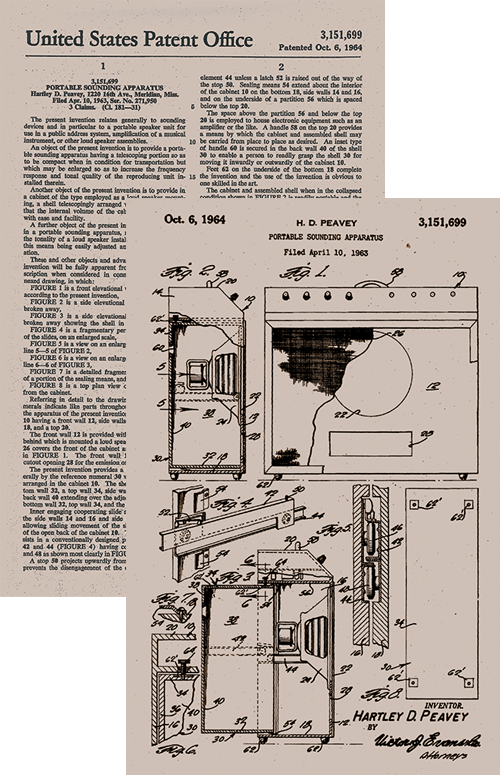Peavey Chapter Two
Peavey: A Brand Is Born
Chapter 2
“In order to be better, by definition you must be different.”
“Brand” is usually defined as a product manufactured by a specific company under a particular name. It’s often synonymous with a design or symbol that identifies a company’s goods as distinct from competitors. For some, brand extends beyond the notion of products sold in a marketplace and takes on a deeper meaning. Brand can determine what a customer feels about a company’s goods and services. That feeling or emotion is what sets a brand apart from competitors.
The Peavey Electronics brand began with a passion for musicians and a calling to address their greatest pain point at that time, the availability of good gear at a fair price. More than 55 years later, Peavey represents Innovation. Amplified.® — a brand founded on the principle of reliable, affordable gear for today’s musicians.


Pivoting to Be Better
The year was 1961. The guitar amplifier schematics had already been laid out as a result of previous design attempts. The engineer, Hartley Peavey, was 19 years old and working in the basement of his family’s home. He had already drawn out the signature lightning bolt logo his senior year of high school. Now it all came down to materials and execution.
The first Peavey-branded amplifier was a tweed-enclosed tube amp. The design was an early success and a sign of what was possible. It encouraged Hartley to keep innovating, if not for his own musical benefit, then for his friends’ use.
By 1964, Hartley, a senior at Mississippi State University, had spent several years trying to be a guitar player but without much success. He managed to get into a few bands and each of these groups needed various pieces of equipment. Hartley would build the gear in his basement workshop on weekends or during school holidays. Unfortunately, a trend developed in which Hartley would be “kicked out” of the band once he built the band’s equipment. After this happened a third time, Hartley resolved it was time to shift gears from playing music to building the things needed to make music.
He had continuously heard his peers say that they “wished somebody would make good gear at a fair price.” That was the spark of innovation that led to the formation of Peavey Electronics Corporation, officially incorporated in 1965.
A Perfect Storm for Innovation
While this young company was forming in Meridian, Miss., the British Invasion had started in earnest in 1963/1964. Conglomerates bought heavily into the music and audio business for the next decade. Typically, the corporate team would arrive and institute new business practices that proved detrimental to these brands. In most instances, the prices went up while the quality of the gear went down, as the companies were passionate about profit but not about music.
By contrast, Hartley brought youthful innovation and a passion for rock ‘n roll to his budding business. He was raised in his family’s music store, and established Peavey’s first workshop in the loft upstairs. In the retail business, he learned from his father to make a “fair and reasonable profit.” The manufacturing business proved to have its own set of demands, and Peavey’s early profit margins were slim.
“If I had any inkling of what I was getting into, I probably would have become a postman so all I would have to worry about is bad dogs and bad weather,” Hartley once joked. “I jumped in there having no idea of what or who I was competing with.”
The market was competitive, but this startup from a small town in Mississippi had identified an unseized opportunity in music manufacturing. Peavey was poised to break through the noise with innovative, reliable designs that were priced affordably and met the needs of modern musicians.

A Breakthrough Design
In 1964, tubes were still “king” in most audio applications. Transistors had started to appear in radios and tape recorders, but few music or audio companies were seriously into “solid-state” designs. It seemed obvious to Hartley that transistors were the next big thing, and he resolved that Peavey’s first products would be transistorized. However, Hartley’s experience was limited to tube amps, and he knew little about transistors. He needed technical guidance and he found a solution in a magazine ad from an Alabama-based company, Orradio, which offered contract engineering work.

Hartley approached the company in 1964 with his idea for a solid-state guitar amp, a design that earned a U.S. Patent by October of that year. Orradio took on the manufacturing, and the first prototype was built using then state-of-the-art Germanium transistors, which sounded impressive. Shortly thereafter, Hartley built a case for the chassis but discovered that as the heat built up inside the cabinet, the transistor bias started to “drift.” The amp that sounded so good in an open chassis was hardly operable when put inside a case.
Hartley went back to Orradio and after demonstrating the problem, the team scrapped the Germanium design in favor of the latest silicon transistors. The team accomplished the rebuild in about 6 weeks and for the first time, Peavey had a good solid-state amp to bring to market.
These first models were called the “Musician,” for the guitar amp, and “Dyna-Bass” for the bass amp, and they were hand-built at a rate of one unit per week. Remarkably, the dual-channel, 35 W amplifiers would represent Peavey’s total product offerings for the first couple of years — a humble beginning for a company that today distributes more than 2,000 products to more than 130 countries, and has earned more than 180 patents in music and audio.
